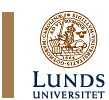

|
Panel No. 12Panel Title: Industrialisation in South Asia – economic, social and environmental aspectsConvenor: Prof. Gunnar Jacks, Dept of Land and Water Resources Engineering, Royal Institute of Technology (KTH), Stockholm, Sweden Tuesday 6 July, 13–18 Panel Abstract: The developed countries
have exported polluting industries to South Asia, such as textile,
leather and metal industries. Also waste materials are exported
and in the receiving countries dealt with little care. These industries
are in many cases economically successful, giving employment to
many people and giving export incomes to the respective country.
However, they are not environmentally sustainable, polluting soil
and water.
Papers accepted for presentation in the panel:Paper Giver 1: Prakash Nelliyat, Madras School of Economics, Chennai, India Paper 1 Title: Socio-economic, environmental and clean technology aspects of textile industries in Tiruppur, South India Paper Abstract: Recently, many of the South Asian countries are experiencing severe environmental problems due to their rapid industrialization. This phenomenon is very common where the polluting industries like textile dyeing, leather tanning, paper and pulp processing, sugar manufacturing, etc. thrive as clusters. The effluents discharged by these industries leads to serious pollution of surface water sources, ground water and soils and ultimately affects the livelihood of the poor. Generally, the above-mentioned industrial units are functioning in small/medium scales with high employment generation and foreign exchange potential. But the pollution control mechanisms among these units are extremely weak. To some extent the pollution enforcement agencies (say the Pollution Control Boards in India) followed a lenient attitude to industries on account of its socio economic contributions and low investment capacity towards pollution control. Unfortunately, this approach further discouraged the industries to introduce successful pollution management strategies either through effective effluent treatment or through production process change through cleaner production technologies. This paper is an attempt to examine the socio economic benefits and environmental impacts of the rapid industrial growth in Tiruppur, a major textile industrial cluster in South India. Besides, the limitations of the existing pollution control practices and the scope for cleaner production approaches among these industrial units are also examined. Full paper to be downloaded (as a pdf-file) Paper Giver 2: Yogesh C. Joshi, Lecturer in Economics, Sardar Patel University, Anand, India, and Rajiv Kurulkar, Management Consultant, Vadodra, India Paper 2 Title: Greening the Golden Corridor: Exploring the possibilities in Ankleshwar and Vapi Industrial Estates of Gujarat, Western India Paper Abstract: The State of Gujarat
has been among one of the top industrialized states in India. During
last decade and more, consistently it has maintained a higher pace
of industrialisation and economic development. Gujarat ranks second
in respect of statewise percentage share in Net Value added by manufacturing
factory sector of India among all the states (Socio-Economic Review,
Gujarat State, 2002-03). In yearr 2000-01 the net value added by
manufacture under factory sector was Rs. 19,149 Cr. (Rs. 19,1490
million). According to annual survey of industries 2000-01, the
industry group of chemical and chemical products accounted for about
48.72 percent of the net value added by the factory sector, followed
by textiles (8.02 percent) in Gujarat. Full paper to be downloaded (as a pdf-file) Paper Giver 3: Faizal Yahya, South Asian Studies Programme, Faculty of Arts and Social Sciences, National University of Singapore Paper 3 Title: The Software Industry: India´s Economic Powerhouse Paper Abstract: The emergence of
India as an attractive outsourcing destination for multinational
corporations around the world is based on India’s strengths
in software development. Despite having one of the highest illiteracy
and poverty rates in the world, India has managed to produced competent
and skilled information technology (IT) workers. India produces
every year approximately 220 000 software and computer science engineers.
In the southern Indian city of Bangalore alone, often regarded as
India’s “Silicon Valley” produces some 25 000
software and computer science engineers, almost as many as the United
States (US). The potential for the IT industry to enhance India’s
economic development is quite evident with a consistent annual growth
rate of 50 percent or more since 1991. The IT industry in India
earned around US $ 8 billion in export services at the end of 2002.
However, the Indian IT industry mainly caters to overseas markets
because of low domestic demand. The rate of penetration for computers
in India is one of the lowest in the world. India’s IT industry
contributes around 2 percent of its GDP, but PC penetration is just
about 6 per 1,000 people. Internet penetration in India has been
able to reach just 1 percent of the total population, with 10 million
users and IT spending as a percentage of GDP is just 0.8 percent.
In comparison countries like China where IT contributes 7 percent
of GDP has a PC penetration of 16 per thousand people. Full paper to be downloaded (as a pdf-file)
SASNET - Swedish South Asian Studies Network/Lund
University
|

